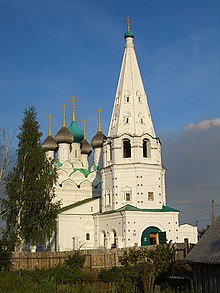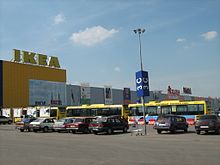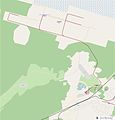| Nizhny Novgorod Oblast | |
|---|---|
| Oblast | |
| Нижегородская область | |
 Flag Flag Coat of arms Coat of arms | |
| Anthem: Anthem of Nizhny Novgorod Oblast | |
 | |
| Coordinates: 56°29′N 44°32′E / 56.483°N 44.533°E / 56.483; 44.533 | |
| Country | Russia |
| Federal district | Volga |
| Economic region | Volga-Vyatka |
| Administrative center | Nizhny Novgorod |
| Government | |
| • Body | Legislative Assembly |
| • Governor | Gleb Nikitin |
| Area | |
| • Total | 76,624 km (29,585 sq mi) |
| • Rank | 40th |
| Population | |
| • Total | |
| • Estimate | 3,234,752 |
| • Rank | 12th |
| • Urban | 79.9% |
| • Rural | 20.1% |
| Time zone | UTC+3 (MSK |
| ISO 3166 code | RU-NIZ |
| License plates | 52, 152, 252 |
| OKTMO ID | 22000000 |
| Official languages | Russian |
| Website | http://www.government-nnov.ru/ |
Nizhny Novgorod Oblast (Russian: Нижегородская область, romanized: Nizhegorodskaya oblast') is a federal subject of Russia (an oblast). Its administrative center is the city of Nizhny Novgorod. It has a population of 3,119,115 as of the 2021 Census. From 1932 to 1990 it was known as Gorky Oblast (Russian: Горьковская область).
The oblast is crossed by the Volga River. Apart from Nizhny Novgorod's metropolitan area (including Dzerzhinsk, Bor and Kstovo) the biggest city is Arzamas. Near the town of Sarov there is the Serafimo-Diveyevsky Monastery, one of the largest convents in Russia, established by Saint Seraphim of Sarov. The Makaryev Monastery opposite of the town of Lyskovo used to be the location of the largest fair in Eastern Europe. Other historic towns include Gorodets and Balakhna, located on the Volga to the north from Nizhny Novgorod.
Geography

The oblast covers an area of 76,900 square kilometers (29,700 sq mi), which is approximately equal to the entire area of the Benelux countries or Czech Republic. Agricultural land occupies 41% of this area; forests, 48%, lakes and rivers, 2%; and other lands, 9%. Nizhny Novgorod Oblast borders Kostroma Oblast (N), Kirov Oblast (NE), the Mari El Republic (E), the Chuvash Republic (E), the Republic of Mordovia (S), Ryazan Oblast (SW), Vladimir Oblast (W), and Ivanovo Oblast (NW).
Natural resources
Nizhny Novgorod Oblast is not rich in natural resources, which are limited to commercial deposits of sand (including titanium-zirconium sands), clay, gypsum, peat, mineral salt, and timber.
History
The sites of Pustyn I and the settlement of Naumovka I, Krasny Bor 5 and others belong to the Mesolithic era in the Nizhny Novgorod region. Burial grounds of the Fatyanovo culture of the Bronze Age were found in the Chkalovsky, Vetluzhsky and Krasnobakovsky districts.
In the course of the regional reform of Peter I in 1708, Nizhny Novgorod with the surrounding lands was added to the Kazan Governorate. In 1714, the Nizhny Novgorod Governorate was created.
On January 14, 1929, the Nizhny Novgorod Oblast was formed. On July 15 of the same year, it was transformed into the Nizhny Novgorod Territory.
On October 7, 1932, the Nizhny Novgorod Territory was renamed the Gorky Territory (in honor of the writer Maxim Gorky). On December 5, 1936, the Gorky Territory was transformed into the Gorky Oblast (the Mari and Chuvash Republics were taken from the former territory).
On January 7, 1954, the Arzamas Oblast was separated from the Gorky Oblast. On April 23, 1957, the Arzamas Oblast was abolished, and its territory was returned to the Gorky Oblast.
On October 22, 1990, by the Decree of the Presidium of the Supreme Soviet of the RSFSR, the Gorky Oblast was renamed the Nizhny Novgorod Oblast. On April 21, 1992, the Congress of People's Deputies of Russia approved the decision of the presidium of the parliament to rename the region, amending Art. 71 of the Constitution of the RSFSR of 1978, which entered into force on May 16, 1992.
Politics

During the Soviet period, the high authority in the oblast was shared between three persons: the first secretary of the Nizhny Novgorod (then Gorki) CPSU Committee (who in reality had the greatest authority); the chairman of the oblast Soviet (legislative power); and the chairman of the oblast Executive Committee (executive power). After the abolition of Article 6 of the Constitution of the USSR in March 1990, the CPSU lost its monopoly on power. The head of the Oblast administration, and eventually the governor, was appointed/elected alongside the elected regional parliament.
The Charter of Nizhny Novgorod Oblast is the fundamental law of the region. The Legislative Assembly of Nizhny Novgorod Oblast is the province's standing legislative (representative) body. The Legislative Assembly exercises its authority by passing laws, resolutions, and other legal acts and by supervising the implementation and observance of the laws and other legal acts passed by it. The highest executive body is the Oblast Government, which includes territorial executive bodies such as district administrations, committees, and commissions that facilitate development and run the day to day matters of the province. The Oblast administration supports the activities of the Governor who is the highest official and acts as guarantor of the observance of the oblast Charter in accordance with the Constitution of Russia.
Sights

The unique architectural construction—the 128-meter (420 ft) steel lattice hyperboloid tower built by the Russian engineer and scientist Vladimir Grigorievich Shukhov in 1929—is located near the town of Dzerzhinsk on the left bank of the Oka River.
Administrative divisions
Main article: Administrative divisions of Nizhny Novgorod OblastDemographics

| Year | Pop. | ±% |
|---|---|---|
| 1897 | 1,584,774 | — |
| 1926 | 2,743,344 | +73.1% |
| 1939 | 3,565,000 | +30.0% |
| 1959 | 3,590,274 | +0.7% |
| 1970 | 3,682,484 | +2.6% |
| 1979 | 3,695,523 | +0.4% |
| 1989 | 3,714,322 | +0.5% |
| 2002 | 3,524,028 | −5.1% |
| 2010 | 3,310,597 | −6.1% |
| 2021 | 3,119,115 | −5.8% |
| Source: Census data | ||
Population: 3,119,115 (2021 Census); 3,310,597 (2010 Census); 3,524,028 (2002 Census); 3,714,322 (1989 Soviet census).
According to the 2010 Census, ethnic Russians at 3,109,661 made up 95.1% of the oblast's population. Other ethnic groups included Tatars (44,103, or 1.4%), Mordva (19,138, or 0.6%), Ukrainians (17,657, or 0.5%), and various smaller groups, each accounting for less than 0.5% of the total. Additionally, 42,349 people were registered from administrative databases, and could not declare an ethnicity. It is estimated that the proportion of ethnicities in this group is the same as that of the declared group.
Vital statistics for 2022:
- Births: 24,032 (7.7 per 1,000)
- Deaths: 48,025 (15.3 per 1,000)
Total fertility rate (2022):
1.31 children per woman
Life expectancy (2021):
Total — 68.93 years (male — 63.81, female — 73.97)
According to the Federal Migration Service, 20,450 foreign citizens were registered in the oblast in 2006. The actual number of foreigners residing in the oblast as of June 1, 2006 was estimated to be over 22,000.
- Religion
| Religion in Nizhny Novgorod Oblast as of 2012 (Sreda Arena Atlas) | ||||
|---|---|---|---|---|
| Russian Orthodoxy | 69.2% | |||
| Other Orthodox | 1.6% | |||
| Other Christians | 2.1% | |||
| Rodnovery and other native faiths | 0.7% | |||
| Spiritual but not religious | 15.2% | |||
| Atheism and irreligion | 10% | |||
| Other and undeclared | 1.2% | |||
According to a 2012 survey 69.2% of the population of Nizhny Novgorod Oblast adheres to the Russian Orthodox Church, 2% are unaffiliated generic Christians, 2% are Orthodox Christian believers without belonging to any church or members of other Orthodox churches, and 1% are adherents of the Slavic native faith (Rodnovery). In addition, 15% of the population declares to be "spiritual but not religious", 10% is atheist, and 0.8% follows other religions or did not give an answer to the question.
Economy


The oblast ranks seventh in Russia in industrial output. Processing industries predominate in the local economy. More than 650 industrial companies employ nearly 700,000 people, or 62% of the workforce involved in material production. Industry generates 83% of the regional GDP and accounts for 89% of all material expenditures. The leading sectors are engineering and metalworking, followed by chemical and petrochemical industries and forestry, woodworking, and paper industries. The first three sectors account for about 75% of all industrial production.
The oblast has traditionally been attractive to investors. In 2002, Moody's rating agency confirmed a Caa1rating based on the region's long-term foreign currency liabilities.

The region maintains trade relations with many countries and has an export surplus. The largest volume of exports goes to Ukraine, Belarus, Switzerland, Kazakhstan, Belgium, and France. Imports come mainly from Ukraine, Germany, Belarus, Kazakhstan, Austria, Netherlands, China, and the United States.
The stock market infrastructure is quite well developed in Nizhny Novgorod, and the exchange business is expanding. Companies and organizations registered in the region include 1153 joint-stock companies, 63 investment institutions, 34 commercial banks, 35 insurance companies, 1 voucher investment fund, 1 investment fund, 17 nongovernmental pension funds, 2 associations of professional stock market dealers, and 3 exchanges (stock, currency, and agricultural). The oblast is noted for having relatively highly developed market relations. Today, the region needs serious partners interested in equitable, long-term, mutually beneficial partnerships.
There are 650+ industrial companies in the region, most of them engaged in the following sectors:
- Machine-building and engineering
- Chemical & petrochemical
- Fuel & energy
- Ferrous and non-ferrous metallurgy
- Construction materials
- Glass
- Wood and paper
- Cloth-making
- Food & food processing
- Medical & pharmaceuticals
- Printing & publishing.
- Peat extraction.
These key industries are supplemented by other sectors of the economy such as agriculture, trade, services, communications and transport.
Transportation
See also: Nizhny Novgorod § Transportation- The Altsevo peat narrow gauge railway is located in the work settlement of Pizhma
- The Pizhemskaya narrow gauge railway is located in the work settlement of Pizhma
- The narrow gauge railway of Caprolactam factory is located in Dzerzhinsk
- The Kerzhenets peat narrow gauge railway is located in the Borsky District
- The narrow gauge railway of Decor-1 factory is located in the Arzamassky District
Narrow gauge railways in the region:
-
 Map Altsevo peat narrow gauge railway
Map Altsevo peat narrow gauge railway
-
 Map Narrow gauge railway of Caprolactam factory
Map Narrow gauge railway of Caprolactam factory
-
 Map Narrow gauge railway of Decor-1 factory
Map Narrow gauge railway of Decor-1 factory
-
 Map Kerzhenets peat narrow gauge railway
Map Kerzhenets peat narrow gauge railway
References
Notes
- Президент Российской Федерации. Указ №849 от 13 мая 2000 г. «О полномочном представителе Президента Российской Федерации в федеральном округе». Вступил в силу 13 мая 2000 г. Опубликован: "Собрание законодательства РФ", No. 20, ст. 2112, 15 мая 2000 г. (President of the Russian Federation. Decree #849 of May 13, 2000 On the Plenipotentiary Representative of the President of the Russian Federation in a Federal District. Effective as of May 13, 2000.).
- Госстандарт Российской Федерации. №ОК 024-95 27 декабря 1995 г. «Общероссийский классификатор экономических регионов. 2. Экономические районы», в ред. Изменения №5/2001 ОКЭР. (Gosstandart of the Russian Federation. #OK 024-95 December 27, 1995 Russian Classification of Economic Regions. 2. Economic Regions, as amended by the Amendment #5/2001 OKER. ).
- Law #20
- Charter of Nizhny Novgorod Oblast, Article 5.5
- ^ Charter of Nizhny Novgorod Oblast, Article 21
- Official website of Nizhny Novgorod Oblast. Valery Pavlinovich Shantsev, Governor of Nizhny Novgorod Oblast Archived October 17, 2012, at the Wayback Machine
- "Путин отправил в отставку губернатора Нижегородской области". РБК. September 26, 2017. Retrieved March 19, 2018.
- "Сведения о наличии и распределении земель в Российской Федерации на 01.01.2019 (в разрезе субъектов Российской Федерации)". Federal Service for State Registration, Cadastre and Cartography. Archived from the original on February 9, 2022. Retrieved August 29, 2023.
- "Оценка численности постоянного населения по субъектам Российской Федерации". Federal State Statistics Service. Retrieved September 1, 2022.
- "26. Численность постоянного населения Российской Федерации по муниципальным образованиям на 1 января 2018 года". Federal State Statistics Service. Retrieved January 23, 2019.
- "Об исчислении времени". Официальный интернет-портал правовой информации (in Russian). June 3, 2011. Retrieved January 19, 2019.
- Official throughout the Russian Federation according to Article 68.1 of the Constitution of Russia.
- ^ "Нижегородская область. Административно-территориальное деление на 1 января 1992 г.". ГИПП "Нижполиграф", Нижний Новгород, 1993, стр. 5
- Т. Д. Николаенко. «Археологическая карта России: Нижегородская область» // Москва, 2004.
- Нижегородская губерния
- Нижегородская область - Нижегородский - Горьковский край - Горьковская - Нижегородская область
- "Указ Президиума Верховного Совета РСФСР от 22 октября 1990 года «О переименовании города Горького в город Нижний Новгород и Горьковской области в Нижегородскую область»". Archived from the original on January 13, 2016. Retrieved January 22, 2022.
- "Общество | Информация о Нижегородской области | История Нижегородского края | Советский период | Административно-территориальное устройство". Правительство Нижегородской области. Archived from the original on January 30, 2016. Retrieved January 13, 2016.
- Закон Российской Федерации от 21 апреля 1992 года № 2708-I «Об изменениях и дополнениях Конституции (Основного Закона) Российской Советской Федеративной Социалистической Республики»
- Законы РСФСР/РФ 1990—1993 и поправки к ним до весны 1995
- Russian Federal State Statistics Service. Всероссийская перепись населения 2020 года. Том 1 [2020 All-Russian Population Census, vol. 1] (XLS) (in Russian). Federal State Statistics Service.
- ^ Russian Federal State Statistics Service (2011). Всероссийская перепись населения 2010 года. Том 1 [2010 All-Russian Population Census, vol. 1]. Всероссийская перепись населения 2010 года (in Russian). Federal State Statistics Service.
- Federal State Statistics Service (May 21, 2004). Численность населения России, субъектов Российской Федерации в составе федеральных округов, районов, городских поселений, сельских населённых пунктов – районных центров и сельских населённых пунктов с населением 3 тысячи и более человек [Population of Russia, Its Federal Districts, Federal Subjects, Districts, Urban Localities, Rural Localities—Administrative Centers, and Rural Localities with Population of Over 3,000] (XLS). Всероссийская перепись населения 2002 года (in Russian).
- Всесоюзная перепись населения 1989 г. Численность наличного населения союзных и автономных республик, автономных областей и округов, краёв, областей, районов, городских поселений и сёл-райцентров [All Union Population Census of 1989: Present Population of Union and Autonomous Republics, Autonomous Oblasts and Okrugs, Krais, Oblasts, Districts, Urban Settlements, and Villages Serving as District Administrative Centers]. Всесоюзная перепись населения 1989 года (in Russian). Институт демографии Национального исследовательского университета: Высшая школа экономики . 1989 – via Demoscope Weekly.
- "Перепись-2010: русских становится больше". Perepis-2010.ru. December 19, 2011. Archived from the original on December 25, 2018. Retrieved August 13, 2012.
- "Information on the number of registered births, deaths, marriages and divorces for January to December 2022". ROSSTAT. Archived from the original on March 2, 2023. Retrieved February 21, 2023.
- "Birth rate, mortality rate, natural increase, marriage rate, divorce rate for January to December 2022". ROSSTAT. Archived from the original on March 2, 2023. Retrieved February 21, 2023.
- Суммарный коэффициент рождаемости [Total fertility rate]. Russian Federal State Statistics Service (in Russian). Archived from the original (XLSX) on August 10, 2023. Retrieved August 10, 2023.
- "Демографический ежегодник России" [The Demographic Yearbook of Russia] (in Russian). Federal State Statistics Service of Russia (Rosstat). Retrieved June 1, 2022.
- Дарья ВЛАДИМИРОВА, "Стройки под особым контролем", Rakurs, 30 June 2006
- "Arena: Atlas of Religions and Nationalities in Russia". Sreda, 2012.
- 2012 Arena Atlas Religion Maps. "Ogonek", № 34 (5243), 27/08/2012. Retrieved 21/04/2017. Archived.
- ^ Arena – Atlas of Religions and Nationalities in Russia. Sreda.org
- "Nizhegorodskaya oblast, Russia guide". russiatrek.org. Retrieved March 19, 2018.
- "Nizhny Novgorod News Network – NN.NN.RU". Government.nnov.ru. Retrieved August 13, 2012.
Sources
- Законодательное Собрание Нижегородской области. №219-З 30 декабря 2005 г. «Нижегородская область. Устав», в ред. Закона №91-З от 21 июня 2016 г «О поправке к статье 6 Устава Нижегородской области». Вступил в силу 28 января 2006 г. Опубликован: "Правовая среда" (приложение к газете "Нижегородские новости"), №3(676), 18 января 2006 г. (Legislative Assembly of Nizhny Novgorod Oblast. #219-Z December 30, 2005 Nizhny Novgorod Oblast. Charter, as amended by the Law #91-Z of June 21, 2016 On the Amendment to Article 6 of the Charter of Nizhny Novgorod Oblast. Effective as of January 28, 2006.).
External links
- Kropotkin, Peter Alexeivitch; Bealby, John Thomas (1911). "Nizhniy-Novgorod (government)" . Encyclopædia Britannica. Vol. 19 (11th ed.). pp. 720–721.
- Official website of the Government of Nizhny Novgorod Oblast Archived November 13, 2015, at the Wayback Machine (in Russian)
- Official website of the Legislative Assembly of Nizhny Novgorod Oblast (in Russian)
- Nizhny Novgorod City Guide Travel and business guide to Nizhny Novgorod
- (in English) Central Eurasian Information Resource; Images of Nizhny Novgorod Oblast – University of Washington Digital Collections
| Subdivisions of Russia | |||||||||||||||||
|---|---|---|---|---|---|---|---|---|---|---|---|---|---|---|---|---|---|
| |||||||||||||||||
| |||||||||||||||||
Categories: